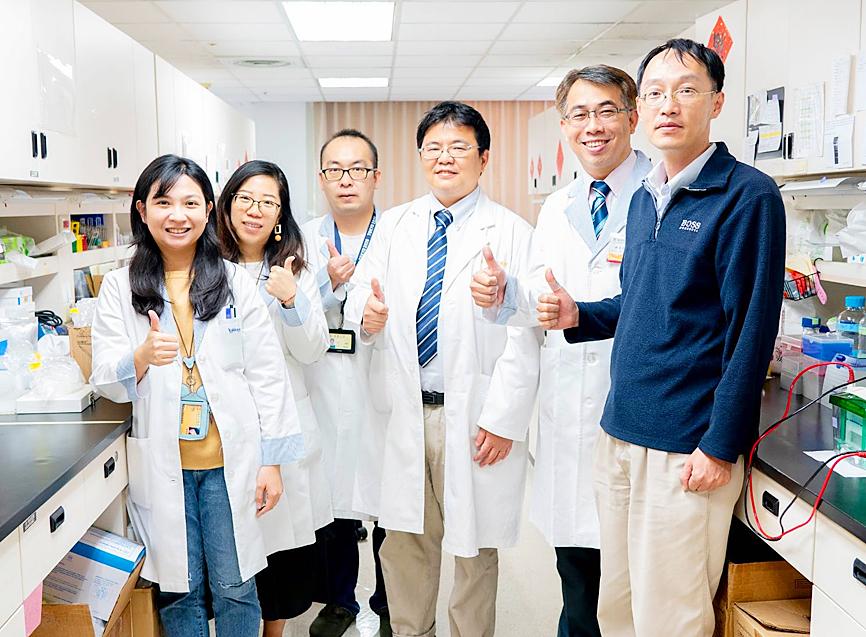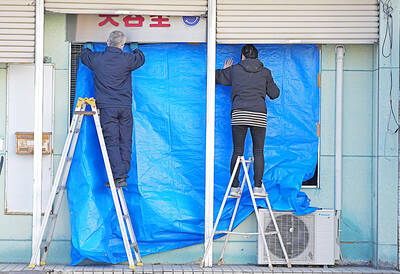Researchers have identified an antioxidant in locally grown black tea leaves as a potential inhibitor of protease activity in SARS-CoV-2, the virus that causes COVID-19, Chiayi Chang Gung Memorial Hospital said on Wednesday.
A research team led by Wu Ching-yuan (吳清源), head of the hospital’s Department of Traditional Chinese Medicine, used a computer program to identify potential antiviral components in traditional plants, the hospital said in a statement.
Theaflavin, a polyphenolic compound, shows broad-spectrum antiviral activity against several viruses and could be used as a lead compound for the development of a SARS-CoV-2 inhibitor to target the DNA-directed ribonucleic acid (RNA) polymerase (RdRp) enzyme.

Photo copied by Lin I-chang, Taipei Times
In coronaviruses, RdRp catalyzes the replication of RNA from a template, making it an attractive candidate to help develop a treatment, Wu said.
RdRp in SARS-CoV-2 is also a primary target for the antiviral remdesivir, which the WHO has called the most promising drug available for the treatment of COVID-19, he said.
Remdesivir works by inhibiting RdRp, which many RNA viruses — including coronaviruses — use to replicate themselves.
The antiviral effects of theaflavin are similar to those of remdesivir, Wu said.
However, the exact in vivo effect is still unclear, and further research is needed to confirm the mechanism whereby theaflavin targets SARS-CoV-2, Wu said.
The findings were published by the American Society for Microbiology in the Journal of Medical Virology on March 13, the hospital said.
In other news, the Central Epidemic Command Center (CECC) on Thursday said that quinoline antimalarial drugs, which have been discussed as a possible treatment for COVID-19, are produced in Taiwan and could be made available if testing proves them to be effective against the novel coronavirus.
In a small French study, doctors used a drug in the quinoline family — hydroxychloroquine — to reduce the duration and severity of COVID-19 symptoms in people with mild cases, said Chang Shan-chwen (張上淳), convener of the center’s expert advisory panel.
If properly tested and approved, a process that normally takes 12 to 18 months, the drug could conceivably reduce the burden on medical resources such as quarantine facilities, Chang said.
Minister of Health and Welfare Chen Shih-chung (陳時中), who heads the CECC, said that there is one manufacturer of quinoline drugs in Taiwan.
If the treatment were proved to be viable, the government’s first priority would be to guarantee domestic supply, Chen said.
The government could participate in the distribution of the drug on the precondition of not harming the manufacturer’s commercial interests, Chen said.
Internationally, drug distribution rights could be used diplomatically to build ties with international partners to address shortages amid the pandemic, he said.
Drugs that have been touted as potentially effective against COVID-19 have become the subject of heated competition in the past few weeks as governments scramble to combat the disease.
Remdesivir is being used on a trial basis in Taiwan and has reduced fevers in the three COVID-19 patients who have been treated with it, although its effect on overall recovery time is still being studied, Chang said.

Taiwanese were praised for their composure after a video filmed by Taiwanese tourists capturing the moment a magnitude 7.5 earthquake struck Japan’s Aomori Prefecture went viral on social media. The video shows a hotel room shaking violently amid Monday’s quake, with objects falling to the ground. Two Taiwanese began filming with their mobile phones, while two others held the sides of a TV to prevent it from falling. When the shaking stopped, the pair calmly took down the TV and laid it flat on a tatami mat, the video shows. The video also captured the group talking about the safety of their companions bathing

US climber Alex Honnold is to attempt to scale Taipei 101 without a rope and harness in a live Netflix special on Jan. 24, the streaming platform announced on Wednesday. Accounting for the time difference, the two-hour broadcast of Honnold’s climb, called Skyscraper Live, is to air on Jan. 23 in the US, Netflix said in a statement. Honnold, 40, was the first person ever to free solo climb the 900m El Capitan rock formation in Yosemite National Park — a feat that was recorded and later made into the 2018 documentary film Free Solo. Netflix previewed Skyscraper Live in October, after videos

Starting on Jan. 1, YouBike riders must have insurance to use the service, and a six-month trial of NT$5 coupons under certain conditions would be implemented to balance bike shortages, a joint statement from transportation departments across Taipei, New Taipei City and Taoyuan announced yesterday. The rental bike system operator said that coupons would be offered to riders to rent bikes from full stations, for riders who take out an electric-assisted bike from a full station, and for riders who return a bike to an empty station. All riders with YouBike accounts are automatically eligible for the program, and each membership account

A classified Pentagon-produced, multiyear assessment — the Overmatch brief — highlighted unreported Chinese capabilities to destroy US military assets and identified US supply chain choke points, painting a disturbing picture of waning US military might, a New York Times editorial published on Monday said. US Secretary of Defense Pete Hegseth’s comments in November last year that “we lose every time” in Pentagon-conducted war games pitting the US against China further highlighted the uncertainty about the US’ capability to intervene in the event of a Chinese invasion of Taiwan. “It shows the Pentagon’s overreliance on expensive, vulnerable weapons as adversaries field cheap, technologically